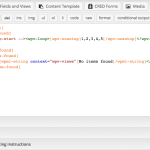No, that is not possible to remove, and I cannot suggest to remove it either.
It is needed for several identifications of the View, it's pagination, Search, AJAX requests, and more.
Now, if you really need to have it gone, you can apply a PHP Filter which is elaborated below, but please acknowledge the several risks outline.
1. The Filter
add_filter( 'wpv_filter_wpv_view_shortcode_output', 'prefix_clean_view_output', 5, 2 );
function prefix_clean_view_output( $out, $id ) {
if ( $id == '375' ) { //Change this to your View ID
$start = strpos( $out, '<!-- wpv-loop-start -->' );
if (
$start !== false
&& strrpos( $out, '<!-- wpv-loop-end -->', $start ) !== false
) {
$start = $start + strlen( '<!-- wpv-loop-start -->' );
$out = substr( $out , $start );
$end = strrpos( $out, '<!-- wpv-loop-end -->' );
$out = substr( $out, 0, $end );
}
}
return $out;
}
2. Use a Views Loop similar to the screenshot
3. Risks and warnings:
- It hooks early in the View output.
- Priority 5 is mandatory
- It only affects a View with an ID of 375, adjust acordingly if needed.
- It only affects Views with actual results: if the View matches no result, the same “No items found” or whatever you have between the wpv-no-items-found shortcode applies.
- It returns only what is between the HTML comments <!– wpv-loop-start –> and <!– wpv-loop-end –> , excluding them. Only content between those HTML comments is returned, as is.
- Notice that, with this applied to a given View ID:
-- Pagination, specially AJAX pagination, will not work.
-- Parametric search, specially AJAXed parametric search, will not work.
-- Other future features will not work either.
So this is to be used if and only if you know what you are doing and you are going to use the View output as source for anything else.
But also notice that this only clears the View structure.
Building as example JSON inside a View output is wrong because we can not address quoting problems.
Please use this with caution.
